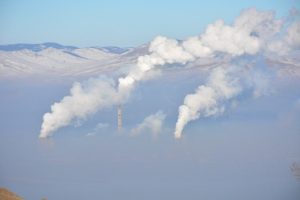Co-authors: Alyssa Middleton, Ph.D. & Maurice A. Ramirez, D.O., Ph.D.
Often referred to as ‘forever chemicals’, Per- and polyfluoroalkyl substances (PFAS) are among the most concerning Fluorinated Hydrocarbons (FHC) pollutants because they do not naturally break down in the environment. These concerns are compounded by the fact that PFAS have been linked to many health problems, including cancer, asthma, and diabetes. Every reader should be concerned because studies estimate 98% of people in the United States have PFAS in their blood. One of the ways people get PFAS into their bodies is by breathing polluted air. There are many ways PFAS get into the air.
Simple acts of cleaning such as vacuuming can release PFAS into the air. When you vacuum a carpet, you not only suck up dirt, dust, and germs, you aerosolize PFAS in the stain-resistant carpet treatment. And it is not just carpets that contain PFAS. Luxury vinyl flooring (LVF) is a popular alternative to expensive hardwood or tile flooring. LVF and the adhesives used to install LVF off-gas (release) PFAS into the air of your home or office. Choosing real or laminate wood flooring does not protect you from PFAS. Wood stains and sealants contain PFAS. Floor wax used on wood floors also contains PFAS. Even tile flooring is not without PFAS exposure. Floor cleaners, grout treatments, sealants and many other floor care products contain PFAS that are released in the air for you to breathe.
And it is not just flooring. Stain resistant and fire retardant treatments on upholstery and linens, in pillows and mattresses, even wall paints often contain PFAS. Since many people spend 90% of their time indoors, they are regularly exposed to PFAS where they live, work, learn, play and worship.
Indoor air is not the only air that contains PFAS. One way experts tried to destroy PFAS was by incineration – burning at very high temperatures. It was thought that the high heat of industrial incinerators would destroy PFAS molecules. However, PFAS chemicals are designed to withstand heat. Even at high heat, PFAS does not burn, instead it escapes into the atmosphere. Many communities near incinerators have high levels of PFAS in the air, water and soil. Governments have banned PFAS incineration, but because PFAS are ‘forever chemicals’ the PFAS already in the atmosphere persist until breathed in by plants, animals and people.
PFAS are also components of the manufacturing processes for thousands of products from aluminum, to commercially produced baked goods, to electronics, to plastics. Even if you do not use the products, the manufacturing processes release massive amounts of PFAS into the atmosphere. Winds and weather spread these PFAS far beyond the factory where the PFAS is used.
It is likely that you and those you love not only already have PFAS in your body but are regularly exposed to PFAS through the air you breathe. This can lead to serious health problems. We must eliminate PFAS-containing products and find ways to safely destroy these chemicals—our health depends on it.
About the Authors:
Alyssa Middleton, Ph. D., has over 20 years of experience working with cancer patients and their families, as well as conducting cancer research. She is the co-author of Five Bugles Institute’s PFAS remediation and replacement educational program. Learn more about Five Bugles Institute’s research at www.fivebuglesinstitute.com/pfas.
Maurice A. Ramirez, D.O., PhD. is the Co-Founder of the High Alert Institute, a 501c3 not-for-profit educational public charity dedicated to providing disaster readiness education and resources to unserved and underserved communities, industries and charitable organizations in an All Hazards, One Health/One Nature, One Framework paradigm. Learn more about the High Alert Institute at www.HighAlertInstitute.org










